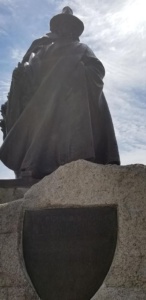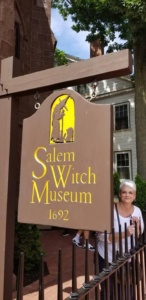They say, “All good things must come to an end.” But do they have to come to such a brutal one?
You growup hearing about the Salem witch trials. You get a little of it in your history lessons. Maybe you research it online. You realize “witch hunt,” the massively popular modern term (especially on Twitter and such), is directly derived from an unfortunate (but fortunately short) historical period in the history of Salem, Massachusetts, and surrounding villages.
These days, the term “witch hunt” is thrown around like a baseball during pre-game warm-up. Trump says the Robert Mueller-led Russian probe is a “witch hunt.” Woody Allen, whose own deviant sexual escapades have come under fire, warned of “witch hunts” in the wake of the Harvey Weinstein sexual abuse case. Witch hunts, it seems, are everywhere. Anyone with an ax to grind should prepare for the accusations of witch-hunting.
In a column entitled “The Modern-Day Witch Hunt”, clinical psychologist Noel Hunter astutely observes:
Fear is a funny thing. When people are afraid, they need to feel a sense of control. Often, control may be perceived when blame is cast and scapegoats are named. If there is someone to blame, then there is something we can do. Fear can lead to irrational postulations of immense proportions; depending on one’s hierarchical position in the world, such postulations may be considereddelusionalor innovative.
In Salem in the years 1692-93, three girls ages 9 to 11 “ one the daughter of the town’s ordained minister, Samuel Parris, and another his niece“ began having seizures or “fits.” They would become violent, babble nonsense, and contort their bodies into weird positions. The devil was assumed to be behind it and the girls were pressed to confess. Under duress, they named three women as responsible for afflicting them.
In January of 1692, Reverend Parris daughter Elizabeth, age 9, and niece Abigail Williams, age 11, started having fits. They screamed, threw things, uttered peculiar sounds and contorted themselves into strange positions, and a local doctor blamed the supernatural. Another girl, Ann Putnam, age 11, experienced similar episodes. On February 29, under pressure from magistrates Jonathan Corwin and John Hathorne, the girls blamed three women for afflicting them: Tituba, the Parris Caribbean slave; Sarah Good, a homeless beggar; and Sarah Osborne, an elderly impoverished woman.
–Smithsonian Magazine
This American phenomenon, oddly, came at the end of a three-century hysteria in Europe, where thousands were executed for witchcraft.
By the time the dust settled and the frenzy subsided, twenty people had been executed as witches and many more imprisoned.
There. Now, when you are in the Boston area and think you might just give the Salem Witch Museum a visit, you can save your money. The history is interesting. The tour is boring and preachy. The main part of the tour has you sitting on backless benches in a room where you are surrounded by a stage that is populated with inanimate dummy figures in settings ranging from cabins to courtrooms. The spotlight will highlight the group of figures coinciding with that portion of the story as the narrator narrates. The story is interesting enough. The technology is roughly Chuck E. Cheese-grade without the animatronics.
After the narration, you go to a hall where pictures and a timeline fill the walls. Some well-spoken kid (no doubt under the witch’s spell of modern groupthink) lectures you on “witch hunts” and spoonfeeds you a healthy dose of LGBTQ alphabet-soup sexual deviance and how they and folks with gender dysphoria are today’s witch hunt victims. Then you are basically proselytized by the good-witch Wiccan religion (Paganism). Without specifically naming or indicting him, the implication throughout the presentation is that all the bad stuff is the result of the influence of Jesus on the world, which was such a pleasant place where good witches cured ills and delivered babies in the Euphoria, BC.
For the second time on our trip to the beautiful Northeast, Donya and I were subjected to a politico-religious agenda. Each time, the message was delivered with fervor and certitude, as though the message were fact, forever settled as such, and wating for the small-minded, mean-spirited Christians…or Republicans…or conservatives to come into the light.
Lucky for us, the beauty we saw and the enjoyable experiences far outweighed the minor annoyance of sermonizing solicitation. Looking back, the only part of the whole journey I would not repeat is the Witch Museum. I think it was twelve bucks for the tour. I would like to have that money back and go buy some New England clamchowder with it.
Speaking of clam chowder, dinner at the hotel that evening featured the best bowl of it I have eaten since the last time I had it on Fisherman’s Wharf in San Francisco, where they put it in a sourdough bread bowl.
This concludes our journey together to the great American Northeast.
Now, excuse me while I go on a “wich” hunt…a sandwich hunt.
Happy trails.


